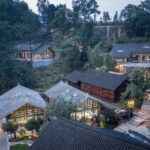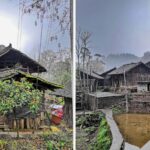Renewing Xinzhaiping Village: A Cultural Regeneration Project in Hunan, China

Project Background
Situated in Luxi County, Tujia-Miao Autonomous Prefecture of Xinangxi, Hunan Province, Xinzhaiping Village stands as a testament to Chinese minority culture, often referred to as the “Museum of Chinese Ancient Trees.” With over 500 trees dating back more than a century, traditional wooden structures, and a predominantly Hmong population, the village boasts a rich cultural heritage. However, like many rural areas, Xinzhaiping faces challenges such as population decline, economic stagnation, and cultural erosion. In response, Sinopec and the China Foundation for Poverty Alleviation initiated the “Bona Villa” rural tourism poverty alleviation project, leading to the Xinzhaiping Renewal Practice undertaken by UPA.
Village Planning and Ecological Restoration
The project focuses on preserving the village’s original texture while integrating modern amenities and services. Traditional houses are transformed into homestays, reception areas, restaurants, and cultural hubs. Public areas, pathways, and landscapes undergo renovation, complemented by ecological restoration efforts initiated by the local government. This holistic approach aims to revitalize the village while maintaining its historical integrity.

Mixing Old and New
UPA adopts a strategy of “mixing old and new,” preserving traditional wooden structures while incorporating modern roofing and wall systems. This integration creates a seamless transition between old and new, with ancient roof frames serving as the main structure of mixed buildings. By expanding functional spaces and enhancing architectural diversity, the project preserves tradition while embracing modernity.
Spatial Typology and Construction
Traditional houses in Xinzhaiping feature wooden frames as the basic structural unit, forming a unified settlement pattern. During renovation, variations such as mezzanines, expanded units, and dislocated connections are introduced to enrich the architectural landscape. Local carpenters employ traditional techniques to preserve wooden structures, while industrialized systems and materials enhance structural integrity and aesthetic appeal.

Cultural Regeneration and Community Engagement
UPA actively promotes cultural regeneration through activities like logo design, heritage collection, and media promotion. Collaborations with universities and rural research initiatives involve stakeholders from various sectors, transforming architects into agents of rural development. The “2021 Rural Construction New Zhaiping/Rural Construction Competition” exemplifies this approach, allowing college students to contribute to the village’s transformation.
Epilogue
The renewal of Xinzhaiping Village symbolizes a harmonious blend of tradition and innovation, breathing new life into a historically rich but economically challenged community. As tourism and local engagement increase, the village serves as a model for sustainable rural development. Beyond physical renovations, the project underscores the importance of preserving cultural identity and fostering community resilience for generations to come.























